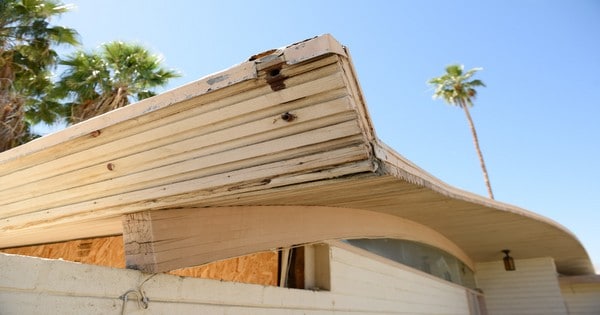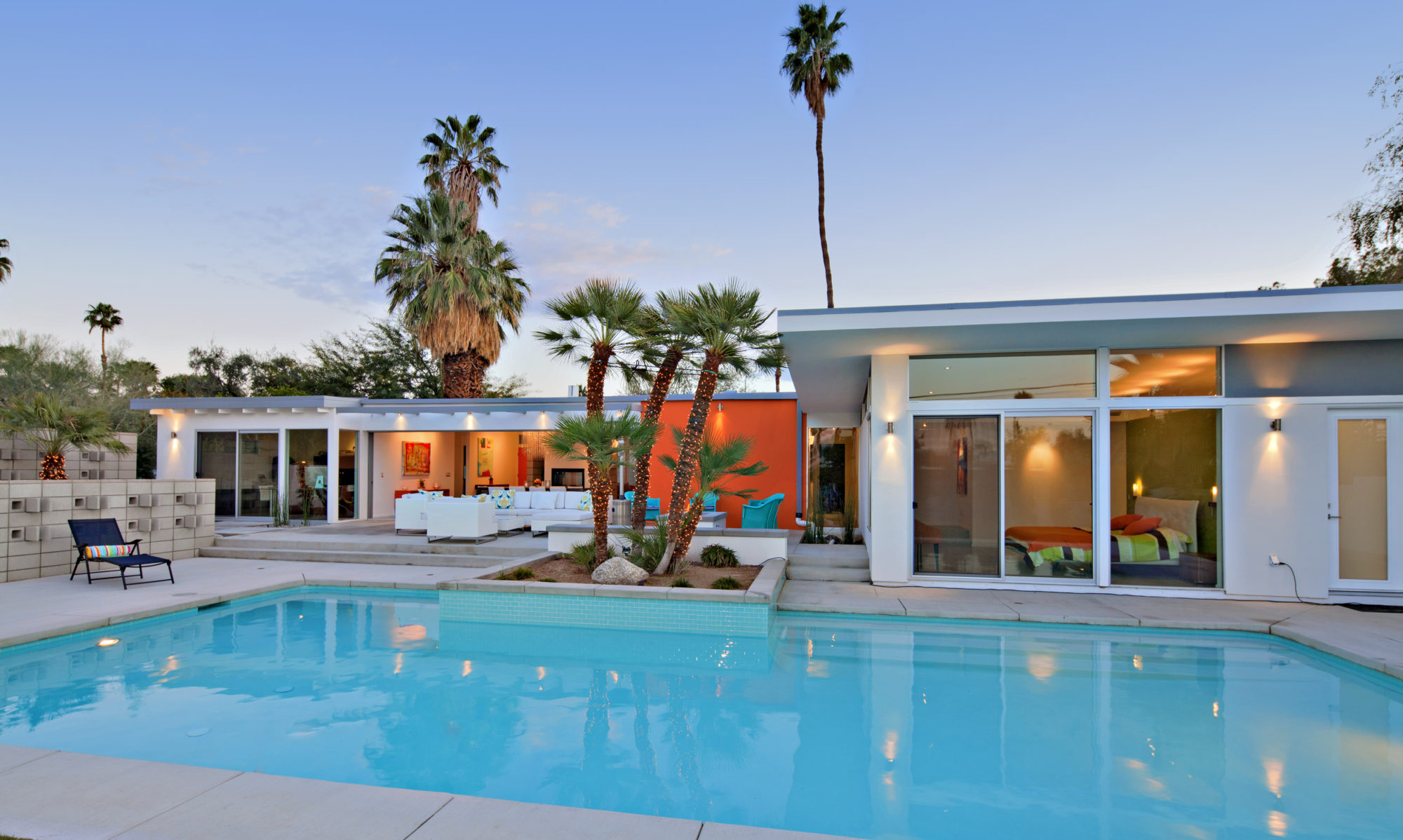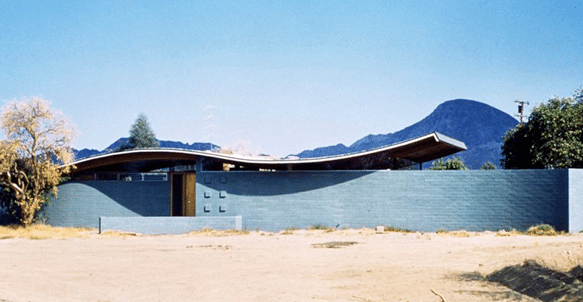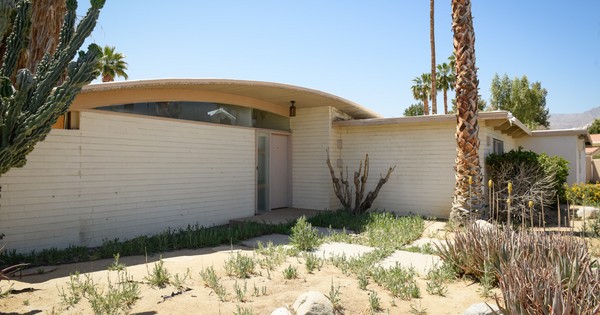Since our last newsletter with Prof. Volker Welter’s commentary on the Miles Bates house (1955) , we were fortunate to participate in a tour of it arranged with the City by Merilee Colton of the Palm Desert Historical Society. Fearing the worst, we were among about twenty, from all points in Southern California, including City staff, able to take advantage of this opportunity last Thursday. Here is the exterior, as original, and as today with two boxy additions on the front in place of the gracefully curved free-standing wall.
Photo Courtesy of the Art, Design and Architecture Museum,
UC Santa Barbara
Existing Condition Photos Courtesy of James Schnepf 2017
The good news, it’s in better shape than it appears from the outside. You can see it from the street at 73697 Santa Rosa Way, Palm Desert.
The House
Surprisingly, from what can be seen, White’s signature roof and the most important character-defining feature, is in fairly good condition, except for needed attention in a few areas for dry rot and minor damage. The exposed ends of the roofing beams, dowels and spacers show some heat-related shrinking and cracking, but not extreme.

The long exposed “tail” of the roof, a laminated wood beam anchored to the ground and supporting a continuation of the roof’s dowels and spacers, has deteriorated due to constant sun exposure, but is capable of restoration.

The roof’s structural integrity appears sound, as does the rest of the house, thanks to White’s generous use of solid brick walls and steel corner columns to frame the sliders.
At some point, large boxy additions were made on the west end of it, but inside the “box” is a surprise – the original outside curved wall (at the right in the picture), and in great condition! It looks easy to remove the box. With that gone, the free-standing wall, restoration of the west and south facing glass sliders and clerestories can make that part of the house whole again. The flared end of the curved roof will once again be in the sky.
There are other changes from the original such as kitchen cabinets and island that are easily removed, and some framing covering air conditioning ducts.
The roof forms the interior ceiling, now painted white. We can see from old photographs and through a section of a kitchen soffit, that it and the supporting beams were stained a warm brown and finished in varnish. Ann Cady Cooper who visited the house while Miles Bates lived there, remembers a free-standing fireplace in the living room. We found it was in the location of the now-existing ceiling fan, below.
Here’s what Ann told us about the house and Miles Bates.
“In its day it was a super cool house that most of Palm Desert talked about, especially because of the roller coaster roof as they called it. There was a lot of music that filled those walls…mostly drums of all kinds. I still have one of the conga drums which I played, taught by Miles Bates. Lots of good conversation took place as well… If there were a number of people, we sat on the floor, especially around the fireplace.
The backyard was full of large steel pieces as well as Miles’ welding gear and always a work in progress. Most of his painting on canvas took place in the house where I live now. He used it as a studio and getaway and always stayed here when we were in town. He loved my parents and was always invited to dinner. It’s really not in terrible condition…could be restored pretty easily. Glad you are doing this”
Additional research will clarify what other items should be addressed. Modern glass is needed of course and a lot of cosmetic work. Bringing it to code would be a major expense if that were required.
At the back of the house (away from the street) the original patio area appears largely intact. On the East side of the house is a zig-zag block wall as in some of White’s other projects.

There is an added building at the rear with three small apartments. We didn’t see the interiors, but they don’t appear to be habitable now. The area and lot is zoned for single and multi-family dwellings.

The Problem
The largest problem facing the Bates House is the California debt (somehow that’s not a surprise). In 2012, the State closed more than 400 local redevelopment agencies, who were ordered to sell off their assets to reduce this debt. The Miles Bates house is caught up in this, because at that time it was owned by the Palm Desert Redevelopment Agency (RDA).
The rules are clear – the assets must be disposed of at the highest possible price. The City does not own the property – it is only managing its disposal.
The City has an appraisal in hand derived from recent sales of single family homes of similar size in the area. None of them have the cultural, historical or architectural value approaching the Bates house, so the appraisal assigns no comparative value to its uniqueness. It values the property at $320,000. An increased value of $20,000 is given for a possible historic designation, which is simply a calculation of the Present Value of the associated Mills Act tax reduction.
To arrive at $320,000, the appraisal includes a price adjustment and allowance to bring the structures out of disrepair. This will make them habitable and usable as a residential income property . This may not be the option the City wants, as the cost now is too high to afford restoration and not high enough to prevent someone from buying it as lower end rental property.
City Staff are prepared to support the designation recommendation of the City Preservation Committee that will go first to the local RDA Oversight Committee, composed of representatives from the various districts that stand to benefit from sale of the house, and then to the State Department of Finance (DOF) for approval of the request for designation.
The terms of the RDA asset disposal is not to sell it for the highest and best use, just the most cash. So the cultural protection value of the property must be seen in the purchase price. The disposal process is now underway and if the schedule is maintained, the sale will happen in a few months.
The appraisal established the property as a residential income property, where the owner can have renters. There is no consideration of the cost to restore the house, and without designation, no consideration of the future protection and restoration of this precious asset.
The appraisal envisions the property standing more or less as it is now, an eyesore of jumbled shapes. As simply a single family home, of modest value, the income from the apartments would not be sufficient to do any significant restoration of the house, and it may be become more damaged with time. A historical designation should protect the house more or less as is, but the public benefit minimal – only the hope that it would survive until it can be sold and properly restored. In that situation, such a new owner would raze the apartments, and spend an enormous amount restoring the house.
Problem Solving
Since it is of brick construction on a concrete slab, it cannot be moved.
Dr. Barbara Lamprecht who successfully prepared the National Historic Properties submission for White’s Dr. Franz Alexander Home (1955) in Palm Springs, was there. She estimated that a State and National designation would take three months and under $10,000. Such a significant designation might sway the City or others into protecting it. Doing this will require at least the City’s approval.
Would the City delay its disposal process while this the national designation process underway, as it may increase the financial value? Is there a higher probability of saving it with a national designation?
All roads lead to the inescapable need to raise money, right now.
$10,000 if the national designation is the solution.
$320,000, as it stands, for outright purchase.
These funds might be raised by a non-profit tax-deductible entity, which would encourage donors. We understand the Historical Society of Palm Desert does not have that kind of money.
There is at least one private party willing to purchase the property, but the high appraisal value and the cost of the rehabilitation (potentially well exceeding the existing purchase price if modern building codes must be met) is a huge obstacle, to all parties.
A new appraisal, taking take full account the ramifications of a historical designation would reduce the price. The assumptions in this appraisal would be that the apartment structure would be removed, the house restored, and as required, brought to code. The additional costs of doing so would reduce the valuation to a practical level and bring many more potential buyers willing to spend hundreds of thousands in restoration. A lower and more realistic appraised price makes survival much more likely.
The City should make the choice, rather than having it made for it, of a small number of low-end, out of place, aging, rental units that don’t meet current Codes, and may result in damage or destruction of a cultural asset, or a restored architectural icon.
But still, first the money.
Is there an investment Angel would like their name attached for posterity to this one of a kind, unique structure that may have a corporate, non-profit, foundation or public use? A company, companies or other organizations that have profited from the development of the Valley and its real estate? Could it be a mid-century modern theme commercial vacation rental? Should it be a community center or an extension of nearby apartments or living facilities?
Is this an opportunity for philanthropic donations from our Snowbirds and Country Clubs in support of maintaining Palm Desert’s cultural heritage?
Is there a practiced fund raiser out there?
Perhaps the City and the Historical Society of Palm Desert can make the Miles Bates house a temporary public exhibit to help seek donations. This would display this well published, unique structure, unique to this City, for public awareness of Palm Desert architecture and to raise funds for its preservation.
Might the City want to protect a national heritage by purchasing it, itself, from its regular budget by making it a priority over some other city expenditures?
Who can help save the roller coaster, wavy roof?
 |
Walter S. White (1917-2002), Miles C. Bates house, Palm Desert, CA, 1954-5,
perspective water color by Siegfried Knop.
Image courtesy of Architecture and Design Collection, Art Design & Architecture Museum, UC Santa Barbara.
© UC Regents.
_ _,_ _





